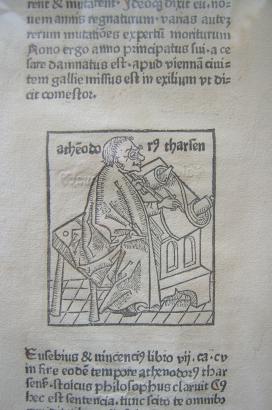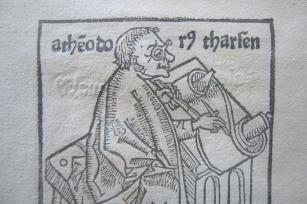|
 |
| Inkwell & Quill |
Square notation has much in common with the main medieval symbol-based technique used to record, recall, and transmit spoken texts: script. The close affinity of writing script to notating music is discoverable in even the most mundane of steps used to translate speech and song into graphic and retrievable forms. Music and text scribes made use of the same draft media, text supports, scribal tools, furniture, and methods of book and document storage. Sources about scribes and their ways are by their very nature sources about notators.
Scribes in the 'square-note era' could be accomplished notators as well, such as Jean de Stavelot (1388-1449), of the Benedictine monastery of St. Laurence of Liège.1 There is evidence that other craftsmen and women may have specialized at times as notators (see the entry notator in the glossary). It is fortuitous that the craft of the notator shared so much with the craft of the scribe, for there has been very little hard critical work on the former. Useful investigations on medieval scribal technology goes back to the nineteenth century, although there has been much less research than commonly assumed.2 Particularly lacking are trials which are carefully planned, meticulously recorded, and fully published, in the manner of experimental archaeology. Much remains to be discovered and recovered regarding the range of scribal tools, their manufacture, and use.
A concern with the experimental archaeology of medieval book production is critical if one is investigating the possible reasons for change in notation, as in script. Nota quadrata, concerned as it is with establishing on a new scientific footing the nomenclature, rise, geographic distribution, and chronological development of sqaure notation, has of necessity to consider the 'how' and the 'why' of notational change. Put simply, was there an instrumental factor in the rise and development of square notation? Did the tools of the notator, either alone or in combination with the requirements of musical practitioners, play a role in the advent and evolution of square notation?3
To begin to answer such questions it is necessary to carefully design trials, using only the tools and technologies which can be documented or reasonably extrapolated for the time and place of the notation under investigation, endeavouring to use all the possible methods that may have been used (within reason), to carefully record the trials, to critically analyse the results, and make them available.4 Needless to say if the trials are to have any relevancy the experimenters will have to acquire a fair amount of dexterity using the tools and techniques they are assessing. Constant and critical comparison with the surviving musical books and their notation will ensure a basic measure of control on the experiments, but the success of the trials will require due vigilance from the experimenters. If a trial and its constraints produces a result which is identical with a surviving medieval notational artifact, then the height of success is to say that the experimenters have found one way the medieval notator, the scribe, and possibly the musical practitioners may have worked. It is also to be expected that much of interest will be revealed during the course of performing the notational and associated scribal practices, rather than just theorizing about them.
Something should be said of the sources. They can be divided into:
- literary sources, both direct and indirect-there are, unfortunately few of these, and they are rarely as informative as one might wish5;
- iconographical sources showing the tools and techniques of the notator-there are surprisingly few images of notators compared to images of scribes,6 but all images of book or document production are potentially informative on the craft of the notator. Some of the images of scribes may be meant to be images of notators, but without notation being shown it is impossible to be certain;
| Athenodorus Tharsen, from Rudimentum novitiorum
|
 |
| Athenodorus Tharsen |
|
 |
| Detail |
|
|
| [Lucas Brandis, Lubeck, 5 August 1475] |
- the archaeological record, consisting of extant scribal tools-scribal tools exist in some number, but no artifact has emerged which can be said to be exclusively a tool for notation and not a tool for text writing in general;
- the vestiges of the tools and techniques visible in the surviving books-traces of tools embedded in notation and script can be surprisingly difficult to identify as definitely made by one rather than another instrument (e.g., aside from assumptions based on the thickness of the minims there is no sure way to tell from a script whether it was written with a quill, reed, or metal pen);
- and ethnographic observation, in this case the scribal practices of traditional and living scribal cultures if they can be identified, as well as the modern craft practices of 'scribes' in the tradition of the revivals of von Larisch, and William Morris and Edward Johnston. The evidence recoverable can be quite valuable but care must be exercised to avoid assuming a modern practice is in an unbroken chain of transmission from the late middle ages; the revived practices of modern scribes may bear as much resemblance to medieval scribal practice as the singing of the monks of Solesme to how chant was actually sung in the middle ages. Unfortunately, none of the traditional scribal cultures which have persisted down to the present day in the teeth of the dominant print and electronic media culture have musical notation.
Where possible all five categories of sources must be used in designing and interpreting the trials.
The first step is to build the necessary equipment with which to run the replications. Chief among these is a scribal station. Eventually four or five will be built to reflect the changes in scribal furniture during the 'square notation era'. For now work has commenced on a close version of a fifteenth-century scribal station, that shown in the Brussels portrait of Jehan Miélot, Brussels, Bibliothèque Royale Albert Ier, MS 9278, saec. XV2, fol. 10r. Blueprints scaled up from the illumination, and a 1:16 scale model based on the drawings will provide the basis for the reconstruction. Although not strictly necessary to the scientific integrity of the experiments in replicating notation, the scribal furniture is being built as much as possible with reproductions or modern versions of the hand tools known to have been used in Western Europe in the fifteenth century.
Pens will also be needed, as will equipment for drafts, such as:
and parchment and paper comparable to fifteenth-century paper, to name but a few of the necessary tools.7
One of the most interesting experiments should be recreating the process of recording medieval music in square notation using the draft media, and eventually performing all the stages from draft, or exemplar, to finished copy, to use in performance. It is expected that informative and enlightening technical issues and insights should arise which cannot even be anticipated at this stage. As many of the sources for the technology of notation are in the first instance sources for scribal technology, so in turn nearly all the experimental work Nota quadrata will undertake is of potential significance in increasing our understanding of scribal technology in general.
Notes
1. Jean de Stavelot was equally skilled at writing square notation and 'Gothic' book scripts, as can be seen in Brussels, BibliothPque Royale Albert Ier, MS 9332-46, dated 1428.
2. The compiling of literary sources in the nineteenth century is epitomized by Wilhelm Wattenbach's Das Schriftwesen im Mittelalter, 3d ed. [Leipzig, 1896].
3. It is only fair to remark that palaeographers have exhibited a laudable reluctance to accept instrumental explanations of script change when it is put forth as the only reason for change, as witness the reactions to the theories of Jean Mallon, Paléographie romaine, Scripturae: monumenta et studia, III [Madrid, 1952], pp. 81-87; 24, 40-41 et passim; Jean Mallon, De l'écriture: recueil d'études publiées de 1937 B 1981 [Paris, 1982], pp. 37-42, 85-86, 93-96, 101-103, 157, 169, 211. A more responsible approach is J. P. Gumbert, 'The Pen and Its Movement. Some General and Less General Remarks', in Gazette du livre médiéval 40 [printemps 2001], 14-24.
4. For an introduction to experimental archaeology in the context of medieval music see: R. A. Rosenfeld, 'Performance Practice, Experimental Archaeology, and the Problem of the Respectability of Results', in Improvisation in the Arts of the Middle Ages and Renaissance, ed. Timothy J. McGee, Early Drama, Art, and Music Monograph Series 30 [Kalamazoo, 2003], pp. 71-97.
5. For example, Michel Huglo, 'Règlement du XIIIe siècle pour la transcription des livres notés', in Festschrift Bruno Stäblein zum 70. Beburtstag, ed. Martin Ruhnke [Kassel..., 1967], pp. 121-133.
6. It seems that images from before ca. 1500 showing notation being written can be counted on the fingers of one hand. Among their number are: St. Gall, Stiftsbibliothek, 390, 'Hartker's Antiphoner', ca. 1000, p. 13, notator [Peter the Deacon?] taking Gregory the Great's dictation; British Library, MS Harley 3011, Liège?, saec. XI med., f. 69v, Gregory the Great as notator; Chapel of San Nicola a Tolentino, vault fresco of the Evangelists and Doctors of the Church by Pietro da Rimini[?] and workshop, 1324-1325[?], Gregory the Great as notator; and Treviso, chapter house of San Nicolb, mural fresco by Tomaso da Modena, 1352, portrait of the Blessed Giovanni da Schio, op; Copenhagen, Det Kongelige Bibliothek, MS Gl. kgl. S. 80 20, Speculum humanae salvationis, Germany, ca. 1400-1450, fol. 47v, Jubal as notator.
7. Others are listed in Randall A. Rosenfeld, 'Tools for Producing Books and Documents in Roman Antiquity and the Middle Ages: A Summary List of Classes', in SCRIPTORIUM vol. 56, no.1 (2002), 156-176.
|